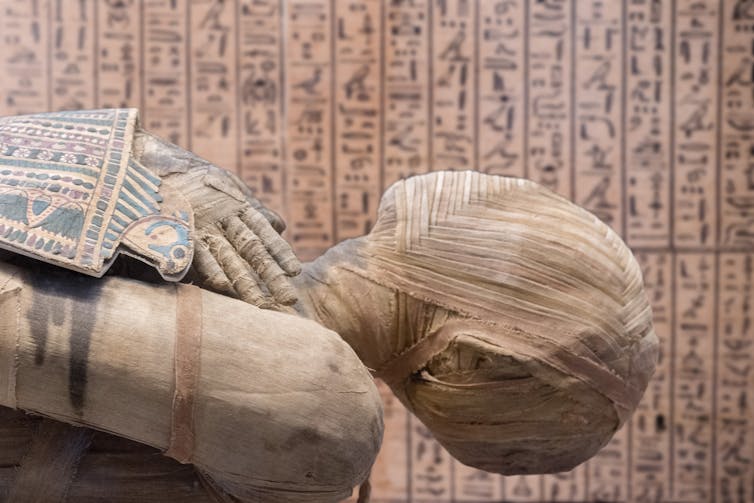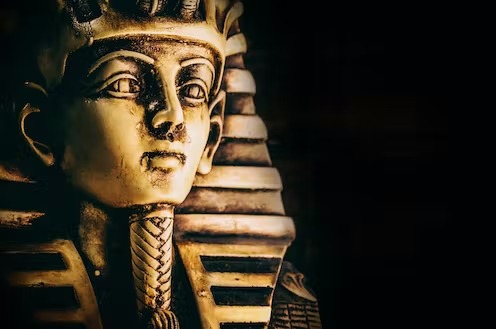Centuries after the first golden coffins were taken to Europe, ancient Egyptian mummies still vividly capture people’s imaginations. Perhaps we’re awed by the grandeur of their rituals and tradition. But new discoveries keep challenging scientists’ perception of these ancient rites.
As a biomedical Egyptologist, I study mummies to learn about life in ancient populations. Over the last 10 years, I have seen a big change in our understanding of how, why and when mummies were created. This has mostly been driven by new scientific discoveries. Here are five of the most important ones that have changed what we know about this ancient process.
1. Mummification is older than archaeologists imagined
For decades, the oldest known mummies came from the Old Kingdom era (c.2500-2100BC) around the time Egyptians started using coffins more. These mummies are rare, but they show signs of being specially prepared by embalmers. Mummies from before the Old Kingdom period were thought to have been created naturally by burying bodies in graves cut into the hot, dry sand. Scientists thought embalming was developed to keep bodies preserved inside coffins.
But chemical tests published in 2014 and 2018 showed that resins and perfumes were already being used to help preserve the skin of the dead over 6,000 years ago, before coffins were common and long before the Old Kingdom era.
2. The ‘recipe’ varied across Egypt
Recent scientific studies of mummies and pots used in mummification revealed how methods differed from place to place and weren’t standardised, as previously thought.
Each region had its own embalming workshops where mummies were produced in a complicated and closely guarded ritual. This secrecy means very few records survived.
Embalmers living in politically important areas such as Thebes (modern-day Luxor) had access to the latest mummification materials, as part of an extensive trade network. In more remote areas such as oases, embalmers had to make do. Natron salt, used to dry the body, was heavy and difficult to transport. Resins and perfumes could be expensive as they were traded over long distances in exchange for other luxury goods.
Instead, the embalmers in these remote areas developed creative techniques. For instance, they used sticks to make mummy bundles more rigid or to attach body parts that fell off during mummification. They also created composite mummies, made up of the parts of several people.
We don’t fully understand how experimentation in mummification emerged in different areas or time periods. There was probably an element of trial and error though.
3. Ancient accounts were not always reliable
The information we have about mummification comes mostly from two ancient Greek writers, Herodotus and Diodorus Siculus. They describe the steps of mummification such as using a hook to remove the brain through the nose. They also tell us the heart was left in the body because it was thought to be important for the afterlife.
Scientific studies using CT scanning have now shown the rules of mummification were less rigid than Herodotus and Diodorus Siculus thought. Only around a quarter of known mummies have their heart left in the body. And many mummies still have their brain. If the embalmers did take the brain out, they sometimes used different methods to avoid damaging the face. Holes have been found in the bottom of the skull and through different routes into the nose.

Not everyone could afford new linens or coffins for their dead loved one. Andrea Izzotti/Shutterstock
4. Egyptians upcycled coffins
In ancient Egypt, wood for coffins was scarce and expensive. Not everyone could afford a new coffin or linen wrappings. A good coffin – but not a luxurious one – in the New Kingdom would cost about five goats or 250 loaves of bread.
Upcycling and recycling are not modern concepts. To save money, embalmers would often take coffins from tombs already in use. These could be repainted to include the name of the new owner or the parts were sometimes used to fashion a new coffin. Tombs were often raided by robbers looking for valuables, and afterwards they were often left open. This made it easy for others to search the tomb for coffins and wrappings to reuse.
Household linens were also often used as mummy wrappings once they outlived their usefulness. Modern research techniques such as radiocarbon dating are showing this practice was widespread. Coffin materials, linen wrappings and other materials are sometimes dated several hundred years older than the person they were buried with.
5. The tourist trade scrambled history
We now know mummies in museums outside of Egypt are not always in the coffins they were discovered in. Many mummies are given a historical date based on their coffin style and decoration. The shape, decoration and religious texts on them changed over time.
But in the 19th and early 20th centuries, mummies were sold to tourists, scientists or collectors. Sellers put well-wrapped mummies into coffins from different tombs to encourage people to buy them. The mismatch only comes to light when a mummy is studied scientifically.
It is now illegal to take mummies or any other ancient artefact from Egypt. There are still a lot of mummies left in private houses though, bought more than a century ago and sometimes forgotten about.
Instead of one unwavering tradition, Egyptian mummification was variable. The funerary rituals available to someone demonstrated how important they and their family were. Being mummified using the most up-to-date techniques and materials not only helped secured a person’s position in the afterlife, it was an important sign of status.
It is impossible to know what the next archaeological or scientific find will show us. But one thing is clear: even ancient embalmers had to improvise sometimes.



 Bitcoin Smashes $93K as Institutions Pile In – $100K Next?
Bitcoin Smashes $93K as Institutions Pile In – $100K Next?  EUR/USD Smashes 1.1660 as ADP Jobs Massacre Crushes the Dollar
EUR/USD Smashes 1.1660 as ADP Jobs Massacre Crushes the Dollar  U.S. Black Friday Online Spending Surges to $8.6 Billion, Boosted by Mobile Shoppers
U.S. Black Friday Online Spending Surges to $8.6 Billion, Boosted by Mobile Shoppers  China Vanke Hit with Fresh S&P Downgrade as Debt Concerns Intensify
China Vanke Hit with Fresh S&P Downgrade as Debt Concerns Intensify  Airline Loyalty Programs Face New Uncertainty as Visa–Mastercard Fee Settlement Evolves
Airline Loyalty Programs Face New Uncertainty as Visa–Mastercard Fee Settlement Evolves  Ethereum Ignites: Fusaka Upgrade Unleashes 9× Scalability as ETH Holds Strong Above $3,100 – Bull Run Reloaded
Ethereum Ignites: Fusaka Upgrade Unleashes 9× Scalability as ETH Holds Strong Above $3,100 – Bull Run Reloaded  Asia’s IPO Market Set for Strong Growth as China and India Drive Investor Diversification
Asia’s IPO Market Set for Strong Growth as China and India Drive Investor Diversification 




























